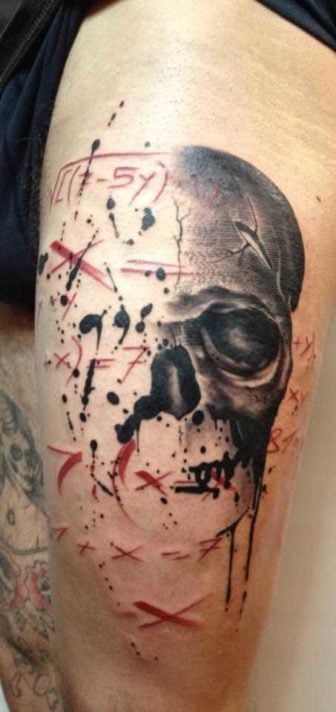Yakuza tattoos are a source of fascination for many tattoo lovers. The high level of secrecy surrounding the tattoos, combined with the painful method of “hand-poking” the designs and the association with the Japanese underworld gives yakuza tattoo art a mysterious appeal.
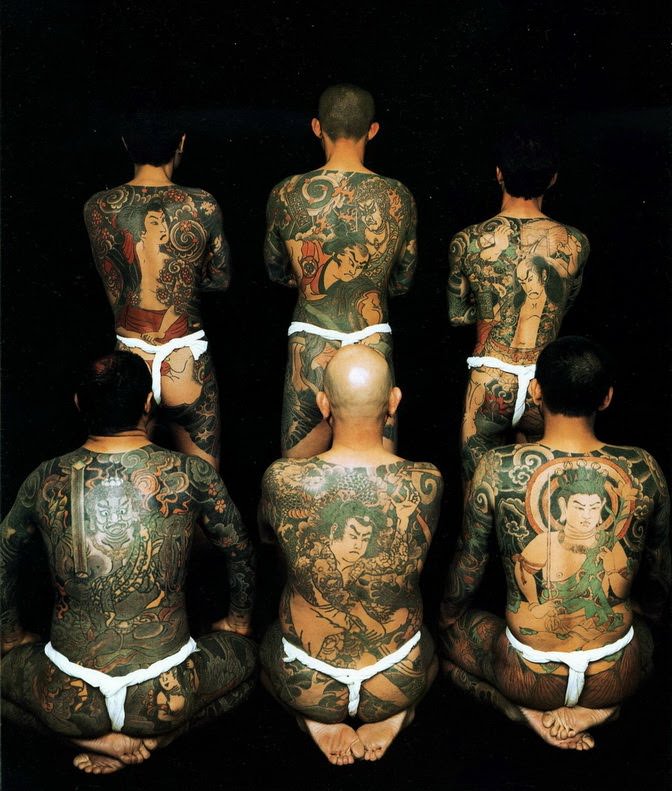
Yakuza gang members pose for a photograph that shows their traditional irezumi tattoo designs. Although the designs are each created in traditional Japanese styles, the content of the design depends on what the owner of the tattoo would like to express to the world. Fierce looking samurai warriors are often shown in yakuza tattoos as a symbol of honor, strength and tradition. [source]
The History of Japanese Yakuza Gang Tattoos
The history of the yakuza begins in the early 17th century in Japan. Members of the Japanese underclass; men who sold stolen or illegal goods or ran gambling dens began to form groups that they called ninkyō dantai (chivalrous organizations). Many of these men had been to prison where they had been tattooed by authorities to mark them as criminals. Early yakuza members began to incorporate tattoo art into the customs and traditions of the group, adding to existing prison tattoos and creating new tattoos as a symbol of status within the organization. Tattoo art wasn’t widely practiced in the region at the time because of the association between tattoos and Japanese criminals.
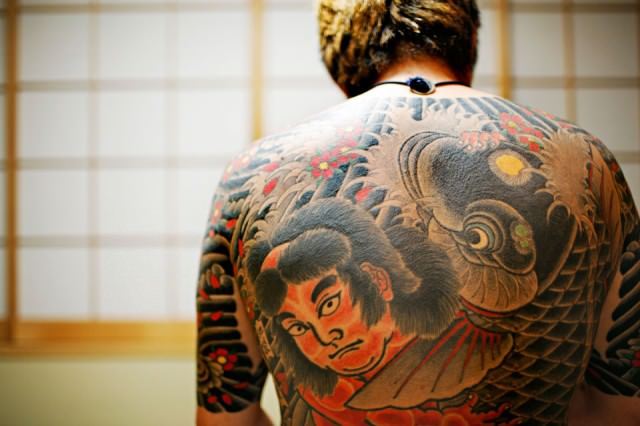
This yakuza tattoo design stops at the neck and elbows so that it can be hidden beneath clothing. This tradition of hiding tattoos from Japanese society began centuries ago when tattoos began to be associated with criminals. [source]
Many traditions formed within the yakuza groups during the next few centuries, including body art and body modification. One tradition, yubitsume, is the act of cutting off the tip of a finger as a way to apologize to the gang for disobedience. Gang members also began to modify their bodies with tattoo designs in a painful process called irezumi (hand poked tattoos) as a way to identify themselves to other yakuza members and wear symbolic imagery on their skin. Because of the painful process, an irezumi body suit is a way for a yakuza gang member to prove their courage and determination. The cost of the tattoos is a symbol of success – being able to afford and entire body suit of irezumi tattoos means the yakuza member is successful in his business pursuits.
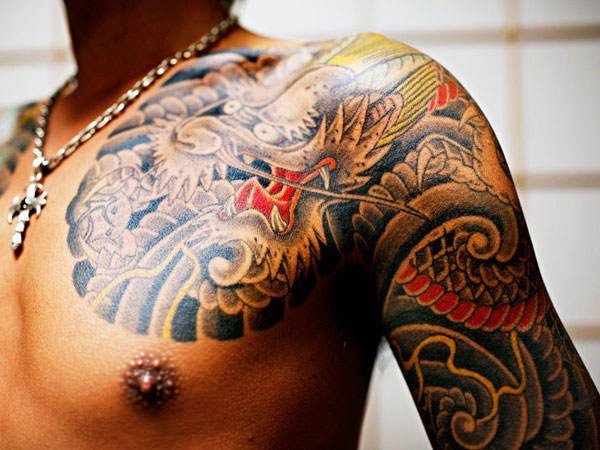
Body modification plays a role in yakuza gang life, including marking the skin with tattoo designs. Like the practice of cutting of a fingertip, yakuza tattoos are a way of marking yakuza gang members for life. [source]
Irezumi, Tattooing the Art of Pain
Irezumi artists begin their careers as apprentices. For the first few years the apprentice cleans the work space, prepares tools and watches the irezumi artist tattooing clients. The apprentice is then allowed to begin practicing designs by drawing them. Only when the apprentice is a competent artist may they begin practicing tattoo art, often on themselves. Many irezumi artists lead fairly mysterious lives and prefer to gain new clients through word-of-mouth rather than advertising their services.
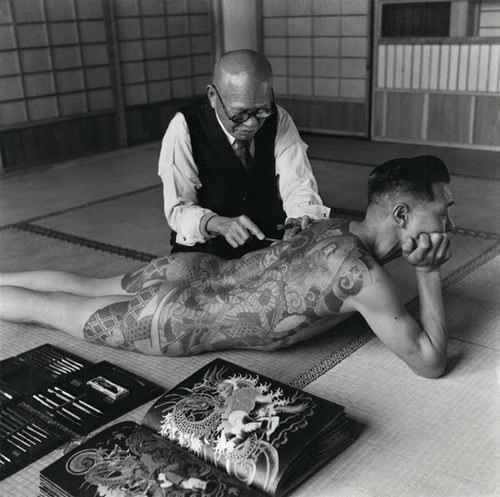
An irezumi artist tattoos a yakuza member with the traiditional hand poking method. These tattoo parlors are very different from modern, westernized tattoo parlors because of the lack of equipment such as electric tattoo machines and adjustable chairs. In irezumi parlors both the client and the artist sit on the floor, a stable surface that enables the tattoo artist to maintain a steady hand. [source]
Hand poked tattoos, known as irezumi in Japan, are created using a “brush” made from either steel or bamboo. The tattoo artist dips the needle tips in ink and repetitively pokes the skin to create a design. Compared to modern, high speed tattoo machines, this method of delivering tattoo ink to the skin is remarkably painful and slow. The traditional yakuza body suit of tattoos can take decades to complete, as the yakuza member can only add to the design when he has time and money available. To see an irezumi artist creating a traditional hand-poked tattoo, watch the video in The Painful Hand-poked Method of Traditional Japanese Tattoos
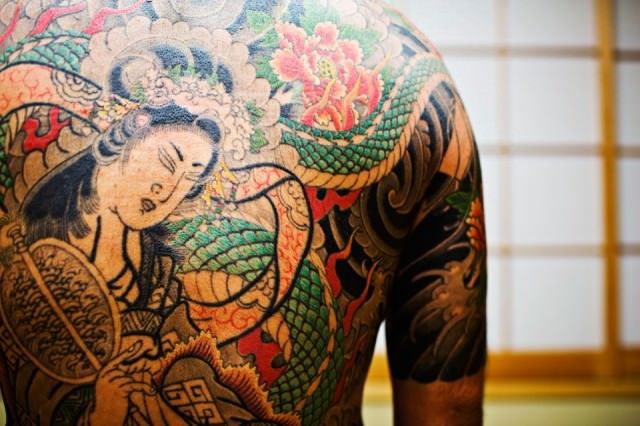
A yakuza tattoo that depicts a geisha figure. The hand poking method of tattooing is painful and the process is slow, meaning that each yakuza tattoo design costs not only money, but time and pain too. [source]
Yakuza Tattoo Body Suits
Because of the connection between criminals and tattoos in Japan, yakuza members traditionally wear their tattoos on parts of the body that can be hidden by clothing. Yakuza tattoos often cover the entire body from the ankles to the wrists and the collar, a placement of body art that means the hands, feet and face can be shown in public without revealing the presence of the body art beneath the clothing. Some yakuza tattoo body suits have a strip of bare skin running down the center of the chest so that the yakuza member can unbutton his shirt without the tattoos being seen.

An irezumi tattoo that shows the yakuza tattoo body suit which can be hidden under clothing. The tattoo design ends at the wrists and neck and leaves an area of bare skin on the chest, which means that the tattoo will only be revealed to the yakuza member’s closest allies and family. [source]
The majority of designs in yakuza tattoos focus on Japanese mythology and history. Dragons and koi fish often appear in yakuza tattoos as symbols of wealth and prosperity. Samurai warriors represent honor and a moral code, while geisha stand as symbols of fertility, good fortune and tradition. Other traditional Japanese designs that feature in yakuza tattoos are lotus flowers and cherry blossoms, tigers and elemental symbols.
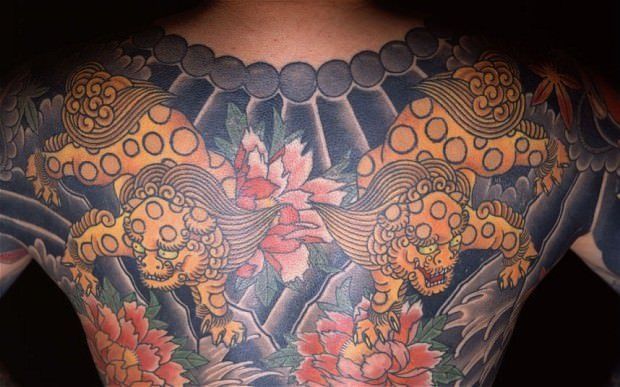
A yakuza gang member wears a tattoo of shisa, a cross between a dog and a lion that protects good spirits and wards off evil spirits. A shisa with a closed mouth guards good spirits while an open-mouthed shisa protects the wearer from evil spirits, The shisa emerge from a lotus flower, a traditional Japanese symbol of beauty emerging from the mud of life – a poignant reminder of the origins of the yakuza gangs. [source]

